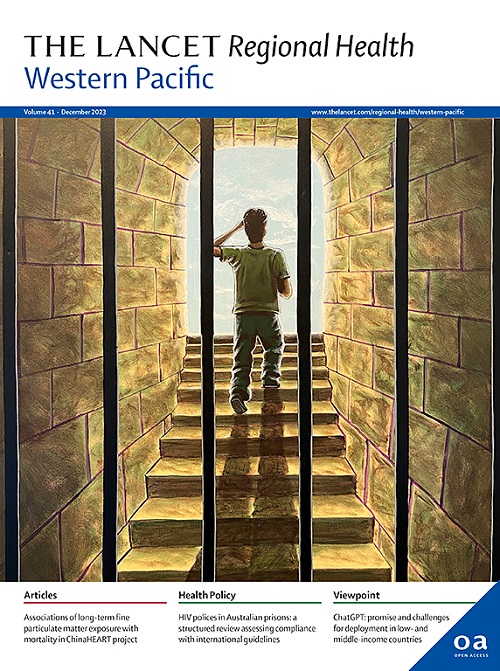Insights from expert elicitation: prioritising pathogens for genome sequencing for Australian public health response
IF 8.1
1区 医学
Q1 HEALTH CARE SCIENCES & SERVICES
引用次数: 0
Abstract
Background
Pathogen genomics has transformed infectious disease response, yet prioritisation frameworks for genome sequencing remain underdeveloped. This study establishes evidence-based criteria for prioritising pathogens for genome sequencing to maximise public health impact in Australia.
Methods
We conducted a modified Delphi study with experts in public health, infection prevention, and pathogen genomics to examine both prioritisation mechanisms, selection criteria and specific pathogen rankings across surveillance contexts. Initially, 38 experts evaluated 89 statements on a 5-point Likert scale with accompanying feedback. In round two, participants reassessed 48 statements, including 28 that were revised based on first-round input. Quantitative data was analysed using STATA-18 and qualitative data using Atlas.ti.
Findings
Consensus was achieved on 53 statements across both rounds across three domains: decision-making processes, prioritisation criteria, and high-priority surveillance scenarios to prioritise specific pathogens for genome sequencing. Experts agreed that a national priority pathogen list for genome sequencing should be developed collaboratively with public health laboratories and complemented by state level lists, with biennial reviews and flexibility for situation-based adjustments. Consensus was achieved on prioritising pathogens associated with antimicrobial resistance, novel and emerging potential, virulence, institutional transmission risk, and disproportionate impact on Aboriginal and Torres Strait Islander communities. For routine surveillance, Mycobacterium tuberculosis received highest consensus for sequencing, followed by multidrug-resistant Staphylococcus aureus. Eleven pathogens were prioritised for sequencing in outbreak investigation, including Carbapenemase producing Enterobacterales, pathogenic Escherichia coli subtypes, and Salmonella species. Three pathogens, Shigella, Neisseria gonorrhoeae, and invasive Group A Streptococcus, were prioritised for periodic surveillance sequencing. Our qualitative analysis showed experts emphasised public health significance and actionability while advocating for balanced national-local governance and cross jurisdictional collaboration to maximise resources.
Interpretation
This study establishes foundational evidence for developing a comprehensive framework for prioritising pathogens for genomic sequencing in Australian public health surveillance and response.
Funding
Australian National Health and Medical Research Council, Medical Research Futures Fund (FSPGN00049).
专家启发的见解:优先考虑澳大利亚公共卫生应对的病原体基因组测序
病原体基因组学已经改变了传染病的反应,但基因组测序的优先级框架仍然不发达。本研究建立了以证据为基础的标准,优先考虑病原体进行基因组测序,以最大限度地提高澳大利亚的公共卫生影响。方法我们与公共卫生、感染预防和病原体基因组学专家进行了改进的德尔菲研究,以检查监测背景下的优先机制、选择标准和特定病原体排名。最初,38位专家在李克特5分制量表上对89项陈述进行了评估,并附带了反馈。在第二轮中,参与者重新评估了48项陈述,其中28项是根据第一轮的输入进行修订的。使用STATA-18对定量数据进行了分析,使用atlas .ti对定性数据进行了分析。结果两轮在三个领域达成了53项共识:决策过程、优先级标准和高优先级监测方案,以优先考虑特定病原体进行基因组测序。专家们一致认为,应与公共卫生实验室合作制定基因组测序的国家重点病原体清单,并辅以州一级的清单,每两年进行一次审查,并灵活地根据情况进行调整。在优先考虑与抗菌素耐药性、新型和新出现的潜力、毒力、机构传播风险以及对土著和托雷斯海峡岛民社区的不成比例影响相关的病原体方面达成了共识。在常规监测中,结核分枝杆菌的测序一致性最高,其次是耐多药金黄色葡萄球菌。在疫情调查中,11种病原体被优先排序,包括产碳青霉烯酶肠杆菌、致病性大肠杆菌亚型和沙门氏菌种。三种病原体,志贺氏菌,淋病奈瑟菌和侵入性A群链球菌,被优先用于定期监测测序。我们的定性分析表明,专家们强调公共卫生的重要性和可操作性,同时倡导平衡的国家-地方治理和跨司法管辖区合作,以最大限度地利用资源。本研究为在澳大利亚公共卫生监测和应对中制定病原体基因组测序优先排序的综合框架建立了基础证据。澳大利亚国家卫生和医学研究委员会,医学研究未来基金(FSPGN00049)。
本文章由计算机程序翻译,如有差异,请以英文原文为准。
求助全文
约1分钟内获得全文
求助全文
来源期刊

The Lancet Regional Health: Western Pacific
Medicine-Pediatrics, Perinatology and Child Health
CiteScore
8.80
自引率
2.80%
发文量
305
审稿时长
11 weeks
期刊介绍:
The Lancet Regional Health – Western Pacific, a gold open access journal, is an integral part of The Lancet's global initiative advocating for healthcare quality and access worldwide. It aims to advance clinical practice and health policy in the Western Pacific region, contributing to enhanced health outcomes. The journal publishes high-quality original research shedding light on clinical practice and health policy in the region. It also includes reviews, commentaries, and opinion pieces covering diverse regional health topics, such as infectious diseases, non-communicable diseases, child and adolescent health, maternal and reproductive health, aging health, mental health, the health workforce and systems, and health policy.
 求助内容:
求助内容: 应助结果提醒方式:
应助结果提醒方式:


